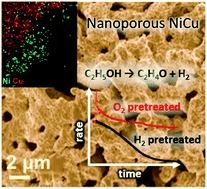Stabilization of a nanoporous NiCu dilute alloy catalyst for non-oxidative ethanol dehydrogenation†
Abstract
Producing acetaldehyde, an important industrial chemical, by direct catalytic non-oxidative dehydrogenation of ethanol presents many advantages over current production methods, including generating hydrogen. However, a stable, active, and selective catalyst is currently unavailable. This work demonstrates that the high activity and selectivity of nanoporous (np) NiCu for this reaction can be stabilized by keeping the catalyst in a metastable (“kinetically trapped”) state. Using a combination of in situ ambient-pressure and ex situ X-ray photoelectron spectroscopy, environmental transmission electron microscopy, and density functional theory calculations enabled correlating changes in surface composition with the changes in activity and stability upon treatment of np NiCu with H2 and O2. Reduction of Ni-doped nanoporous Cu by H2 exposure enhanced the initial activity but led to complete catalyst deactivation within ∼40 hours. In contrast, O2 pretreatment of the same catalyst increased both activity and long-term stability, with only 15% activity loss over 40 hours. The stability of np NiCu as a catalyst inversely correlates with the amount of metallic Ni at the surface, which is enriched by the H2 pretreatment, while the O2 pretreatment leads to a kinetically trapped Ni2+ subsurface state. This work emphasizes that detailed understanding of pretreatment-induced nanoscale structural and compositional changes is necessary to optimize catalyst performance.



 Please wait while we load your content...
Please wait while we load your content...
